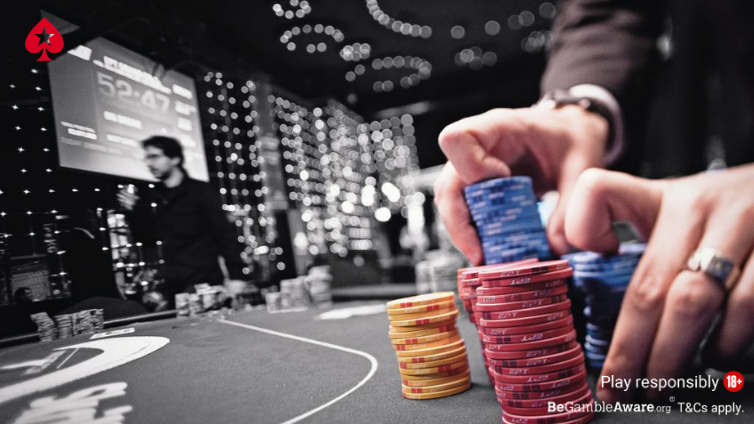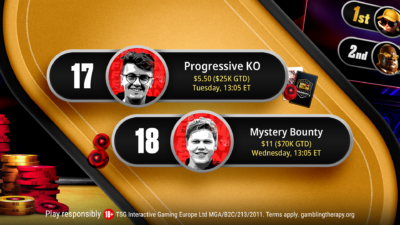Bluffing is one of the most important skills in poker. Without it, you can only rely on hitting strong hands to win pots. This article explores what a bluff is, why it’s important, and how you can start bringing profitable bluffs into your game. It’s a technical subject, so we’ve included plenty of links to PokerStars Learn along the way…
What is a bluff?
In the simplest of terms, there are two reasons to bet in poker:
- Value bet – Betting with what you believe to be the strongest hand in order to get value and build a pot. Value betting includes “protection bets” in which the aim is to make an opponent pay to see future cards.
- Bluff – Betting with the intention of getting an opponent to fold a potentially stronger holding.
You can make a bluff pre-flop or post-flop. It can be a single raise or a re-raise. It can happen on one street or over the course of an entire hand. But by definition bluffing must be an aggressive action – after all, the aim is to force villain to fold.
See this article from PokerStars Learn to understand more about the purposes of betting.
Why is bluffing important?
Bluffing is important in both live poker and when playing poker online. If you never bluff, then you always have to rely on having the best hand at showdown in order to win pots. Bluffing is a large part of what gives winning players an edge. It gives you more ways to win the pot, and also stops you becoming too predictable.
That said, bluffing too often, or in the wrong situations, can be a huge mistake. You can lose a lot of chips this way and become a different kind of predictable. Observant players will simply adapt by calling you down much wider.
The key is to find a reasonable frequency of bluffing and to bluff when it is profitable to do so, mixing up your play to keep players guessing.
You can take the PokerStars Learn lesson on bluffing here.


PokerStars Learn is an excellent resource for improving your bluffing skills
When is bluffing profitable?
Bluffing is one of the fundamental skills in poker, but does have its limitations. You should only attempt to bluff when the situation seems favorable. Seeing as your aim when bluffing is to force opponent(s) to fold, it makes sense that you want to do it when that seems a likely outcome.
There are a number of factors you’ll want to consider before making a bluff, including:
- Board texture – is the flop dry or full of possible draws?
- Villain’s range – how likely is it villain has made a hand?
- Your perceived range – how likely is it you could be holding the hand you’re representing?
- Villain’s tendencies – does villain usually fold when they miss, call too much, or fire back often?
- Stack depths – are stack depths such that you can apply pressure?
- Table image – do you have a tight image, or have you made lots or raises and been caught bluffing in previous hands?
For example, you raise pre-flop and have position over a tight medium stacked opponent. The board comes dry Ace high. Your image is tight and you have a big stack. In this case, it’s very likely that villain will fold to a bluff bet if they do not have an Ace, making it a typical spot for a bluff.
The more the factors above align, the more likely it is your bluff will succeed (in poker terms, the more fold equity you will have).
The art of the semi-bluff
When learning how to play poker, one of the most profitable ways to introduce more bluffs to your game is the semi-bluff. In this case, you are not betting purely for value or purely as a bluff, but as a combination of the two.


Strong flush draws make for potentially profitable semi-bluffs
The semi-bluff is an aggressive way to play your hand when you have the potential to improve on later streets. Semi-bluffing hands are typically flush draws, straight draws, or combination draws that could include flush draws, straight draws and overcards.
Semi-bluffing gives you two ways to win the pot. You can take it down with one or more bluff bets, or you can catch your draw and make the best hand. When you do make the best hand, you’ll often be in a position to bet for value and build an even bigger pot.
In technical terms, the profitability of a given semi-bluff is split between the pot equity and fold equity of the hand. Weak draws won’t have a lot of pot equity, so you will need more fold equity to make them profitable. Strong draws will have lots of pot equity, so fold equity won’t be so much of an issue (in other words, weaker draws ere more towards a bluff and stronger draws ere more towards a value bet).
Nick Walsh explains in the following PokerStars Learn videos on semi bluffing:
NICK WALSH ON SEMI-BLUFFING
CHECK RAISING AS A SEMI-BLUFF
LEARN MORE ABOUT BLUFFING
Check out this selection of articles from PokerStars Learn for general advice on bluffing and focused strategy tips for particular situations. Have a look through these and you’ll be a better bluffer in no time!
BLUFFING IS FUN
FINDING BLUFFS WHERE OTHERS DON’T
FINDING UNPLANNED BLUFFS
BLUFFING SMALL ON THE RIVER
PULLING THE TRIGGER ON BIG BLUFFS
SOMETIMES YOU JUST HAVE TO BLUFF
TRIPLE BARREL BLUFFS
CAN WEAK PLAYERS BE BLUFFED
Back to Top








